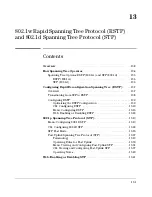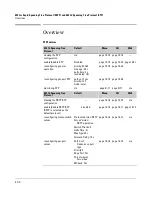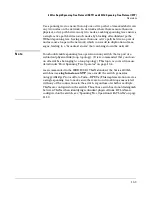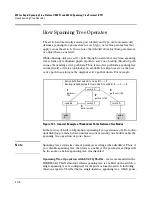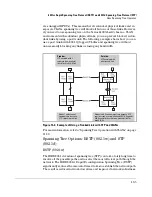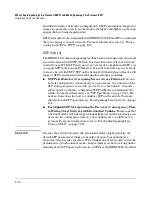
12-11
Multimedia Traffic Control with IP Multicast (IGMP)
How IGMP Operates
How IGMP Operates
The Internet Group Management Protocol (IGMP) is an internal protocol of
the Internet Protocol (IP) suite. IP manages multicast traffic by using
switches, multicast routers, and hosts that support IGMP. (In Hewlett-Pack-
ard’s implementation of IGMP, a multicast router is not necessary as long as
a switch is configured to support IGMP with the
querier
feature enabled.) A set
of hosts, routers, and/or switches that send or receive multicast data streams
to or from the same source(s) is termed a
multicast group
, and all devices in
the group use the same multicast group address. The multicast group running
version 2 of IGMP uses three fundamental types of messages to communicate:
■
Query:
A message sent from the querier (multicast router or switch)
asking for a response from each host belonging to the multicast group. If
a multicast router supporting IGMP is not present, then the switch must
assume this function in order to elicit group membership information
from the hosts on the network. (If you need to disable the querier feature,
you can do so through the CLI, using the IGMP configuration MIB. See
“Changing the Querier Configuration Setting” on page “Configuring the
Querier Function” on page 12-10.)
■
Report (Join):
A message sent by a host to the querier to indicate that
the host wants to be or is a member of a given group indicated in the report
message.
■
Leave Group:
A message sent by a host to the querier to indicate that the
host has ceased to be a member of a specific multicast group.
An IP multicast packet includes the multicast group (address) to which the
packet belongs. When an IGMP client connected to a switch port needs to
receive multicast traffic from a specific group, it joins the group by sending
an IGMP report (join request) to the network. (The multicast group specified
in the join request is determined by the requesting application running on the
IGMP client.) When a networking device with IGMP enabled receives the join
request for a specific group, it forwards any IP multicast traffic it receives for
that group through the port on which the join request was received. When the
client is ready to leave the multicast group, it sends a Leave Group message
to the network and ceases to be a group member. When the leave request is
detected, the appropriate IGMP device will cease transmitting traffic for the
designated multicast group through the port on which the leave request was
received (as long as there are no other current members of that group on the
affected port).
Содержание ProCurve 4104GL
Страница 1: ...hp procurve series 4100gl switches management and configuration guide www hp com go hpprocurve ...
Страница 2: ......
Страница 26: ...xxiv Getting Started Need Only a Quick Start ...
Страница 34: ...1 8 Selecting a Management Interface Advantages of Using HP TopTools for Hubs Switches ...
Страница 50: ...2 16 Using the Menu Interface Where To Go From Here ...
Страница 172: ...8 24 Time Protocols SNTP Messages in the Event Log ...
Страница 240: ...10 30 Configuring for Network Management Applications CDP ...
Страница 288: ...11 48 Port Based Virtual LANs VLANs and GVRP GVRP ...
Страница 350: ...13 42 802 1w Rapid Spanning Tree Protocol RSTP and 802 1d Spanning Tree Protocol STP Web Enabling or Disabling STP ...
Страница 480: ...C 38 Troubleshooting Restoring a Flash Image ...
Страница 486: ...D 6 MAC Address Management Determining MAC Addresses ...
Страница 490: ......
Страница 502: ...12 Index ...
Страница 503: ......

























